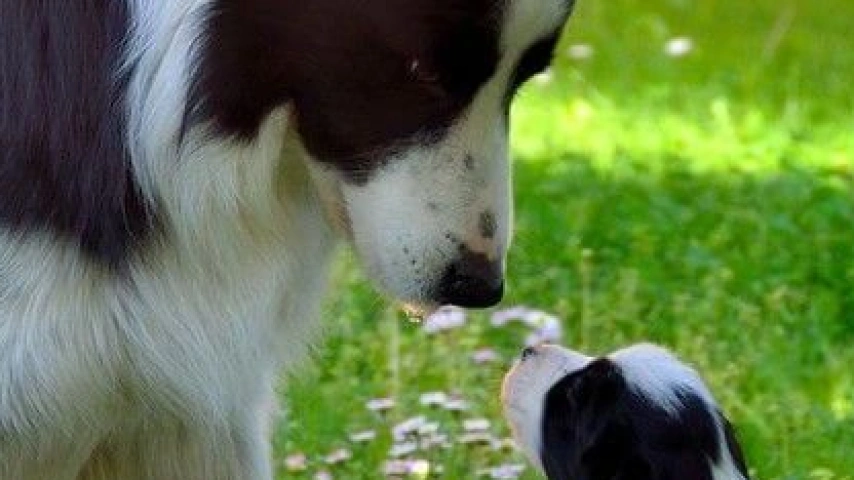Dog / Detail
Preparing Your Dog for a New Canine Companion
Jonathan Bennet | 27 September 2024 | 12:05
Introducing a new dog into your household, whether it's a puppy or an adult, can be an exciting time. However, it's important to be mindful of your current dog's feelings and prepare them for the change. Jealousy can arise between dogs, especially if they have different breeds or personalities.
By taking proactive steps, you can help ensure a smooth transition and foster harmonious relationships between your furry friends.
Remember, introducing a new dog into your household can take time and patience. By following these tips and being mindful of your current dog's feelings, you can help ensure a smooth transition and foster harmonious relationships between your furry companions.

Jealousy is a natural canine behavior that can manifest in various ways. Signs of jealousy in dogs may include:
- Increased barking or howling: This can be a way for your dog to express their discomfort or frustration.
- Aggression: While uncommon, aggressive behavior towards the new dog can be a sign of jealousy or territoriality.
- Whining or whining: Your dog may whine or whimper to get your attention or express their distress.
- Destructive behavior: Chewing, digging, or other destructive behaviors can be a way for your dog to cope with jealousy or anxiety.
- Withdrawal: Your dog may become withdrawn or less affectionate.

- Positive Reinforcement: Before introducing the new dog, spend extra time reinforcing positive behaviors with your current dog. Reward them for good behavior, such as sitting, staying, or coming when called. This will help strengthen your bond and boost their confidence.
- Socialization: If your current dog is not used to interacting with other dogs, gradually introduce them to new canine companions in a controlled environment. This will help them become more comfortable around other dogs and reduce their fear or anxiety.
- Create a Safe Space: Designate a quiet, private space for your current dog where they can retreat and feel secure when the new dog is present. This will give them a sense of control and help them feel less overwhelmed.
- Consistent Routine: Maintain a consistent daily routine for your current dog, even during the transition period. This will provide them with a sense of stability and security.
- Individual Attention: Make sure to continue providing individual attention to your current dog, even when the new dog is around. This will help them feel loved and valued.

Introducing the New Dog
- Gradual Introduction: Introduce the new dog slowly and in a neutral environment, such as a park or a friend's yard. This will help minimize any territorial behaviors.
- Supervised Interactions: Always supervise interactions between your dogs, especially at first. This will allow you to intervene if necessary and ensure that they are getting along.
- Positive Reinforcement: Reward both dogs for good behavior during their interactions. This will help them associate positive experiences with each other.
- Separate Mealtimes: Feed your dogs separately at first to avoid competition and territorial disputes.

Addressing Jealousy
- Redirect Attention: If you notice your current dog exhibiting signs of jealousy, redirect their attention to a favorite toy or activity. This will help them focus on something positive and reduce their anxiety.
- Spend Quality Time: Make sure to spend quality time with both dogs individually, as well as together. This will help them feel loved and valued by you.
- Consult a Trainer: If jealousy is becoming a significant problem, consider consulting a professional dog trainer. They can provide you with specific guidance and techniques to help manage the situation.
Related
-

The Healing Power of Dogs: How Canine Therapy is Revolutionizing Mental Health and Boosting Positive Energy in Humans
Dog14 November 2024
-

A Pawsitive History: Dogs of Nuremberg
Dog09 November 2024
-

The Role of Oxytocin in the Human-Dog Bond: The Science Behind Our Deep Connection
Dog06 November 2024
-

Beyond the Beach: Jamaica's Dog Lovers
Dog29 October 2024
-

A Dog's Delights: Homemade Snacks for Our Furry Babies, Recipes Included!
Dog29 October 2024
-

A Dog's Disorientation: Understanding Your Dogs' Wanderlust
Dog29 October 2024
Popular
-

-

A Pawsitive History: Dogs of Nuremberg
09 November 2024 -

-

Beyond the Beach: Jamaica's Dog Lovers
29 October 2024 -
